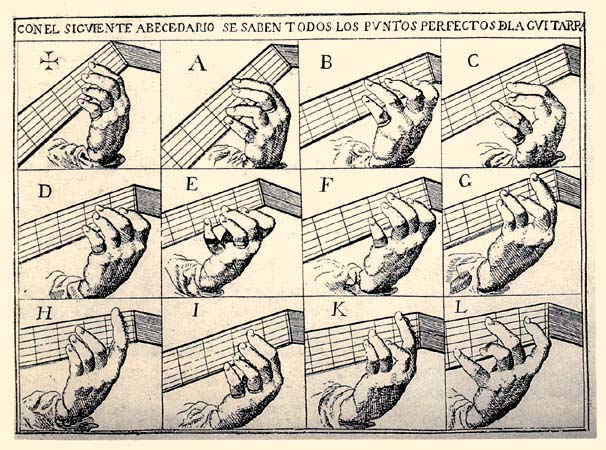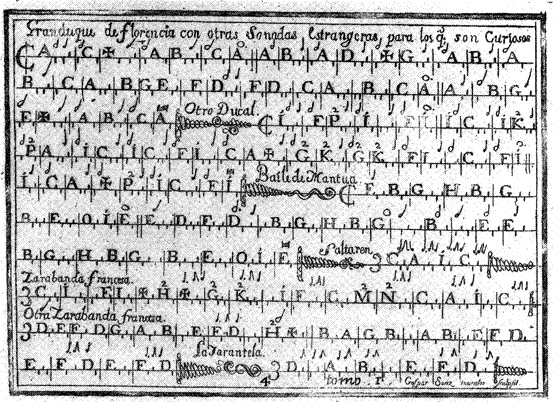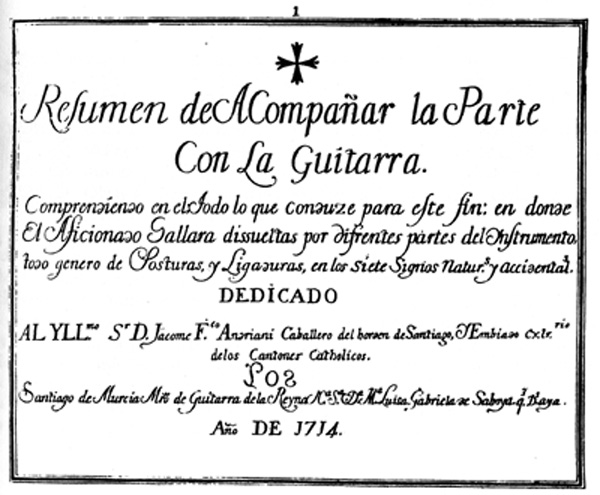THE SPANISH SCHOOL OF BAROQUE GUITAR

From 1606 to about 1629 the only known style of guitar music found
in manuscripts was that using the Alfabeto system.
The Spaniard Francisco Palumbi (c. 1595) wrote a manuscript in Italian, assigning different letters of the alphabet to each chord on the fingerboard. Under the letters there were vertical lines to indicate the direction of the stroke, up or down. His music consisted of Spanish songs, chordal accompaniments, chords sequences of well known dances like folias, ciaccona and zarabanda.
There were two systems of Alfabeto in Spain. The Castilian system used by Briceño and Ribayaz, and the Catalan system, used by Amat and Minguet.
Castilian System as illustrated by Briceño in his 1626 book, presents chords in French tablature and places numbers and other signs above the chords.

The second Catalan system comes from the Catalonian Doctor Juan Carlos Amat (1596)
"Guitarra Española" published in Barcelona. This system assigned letters
instead of numbers to each chord. He also gives precise tunning instructions
at a nominal pitch which soon became standard. The tunning given is the same
as our modern day guitar. His book went through several editions, and remained
in print until the XIXc.
Below is Amat's Catalan's system which appeared in Minguet' s book of 1774. All twelve major and minor chords beginning with 1n (natural) to 12n, then 1b (b molado) to 12b are illustrated.
Minguet y Yrol": Reglas y Advertencias (1774)

Alfabeto piece from Gaspar Sanz: Instrucción (1674)

"The Baroque Guitar in Spain and the New World"
Gaspar Sanz, Antonio de Santa Cruz, Francisco Gerau, Santiago de Murcia.
The Frank Koonce Series. Mel Bay.
The earliest sources of the baroque guitar come from the early XVII c. from Amat's "Guitarra Española"(1596) and Antonio de Santa Cruz " Música de Vihuela", and ends with a final reprint of Amat's book in 1774.
Nicolao Doizi de Velasco, a Portuguese at the service of Philip IV of Spain, published the first detailed book for instruction in (1640). It teaches, theory, intabulating, stringing and tuning.
Gaspar Sanz (1640-1710)
published the first collections of music, "Instrucción
de Música sobre la Guitarra Española", first published
in 1674 in Saragossa. A second book entitled "Libro
Segundo de cifras sobre la guitarra española" was printed
in Saragoza in 1675. A third book, "Libro tercero
de mùsica de cifras sobre la guitarra española",
was added to the first and second books, and all three were published together
under the title of the first book in 1697, there were eight editions, the last one in 1697.
He traveled to Naples
where he became the organist in the Royal Chapel, then to Rome, where he started
his guitar studies. Sanz's teacher was Lelio Colista and Purcell. It was in
Rome that he studied the works of great guitarists such as Foscarini,
Granata and Corbetta. Sanz was more interested in popular forms, very
lively and accessible, Spanish and Italian pieces, settings of passacalles,
preludes, pavanes
and the famous canarios etc.
Canarios by Gaspar Sanz- Chatham Baroque Ensemble
Gaspar Sanz Master of the Spanish Baroque Guitar by John Patikula- Guitarra Magazine
| Excerpt of Italian Alfabeto sytem |  |
Don Lucas Luis de Ribayaz (1626-?) book" Luz y norte musical... (1677) has extremely valuable information on guitar technique and ornamentation.
Francisco Guerau (1649-?) His publication of 1694 is comprised of works notated entirely on punteado style. He gives us settings of popular pieces such as xacaras, mari-zapalos, marionas and canarios, plus settings of passacalles in every key. He was the teacher of the Queen Doña María Luisa de Saboya, and it is very likely that he played continuo in the operas and concerts at the court of Madrid. Gerau was Santiago de Murcia's teacher.
Santiago de Murcia (1685-?) "Resumen de Acompañar la Parte con Guitarra" (1714) is the finest five course guitar music. The Resumen includes a lengthy introduction to the art of accompanying the voice and other instruments . In his second book " Pascalles y obras de guitarra por todos los tonos naturales y accidentales", he gives a complete treatment of the three chords of the Passacaglia and the four compas which had been the foundation of religious, secular, formal, and folk music for centuries.
His
music is influenced by the French school, (his baroque
suite follows the arrangement of, prelude, allemande, courant, sarabande,
guige and gavotte, and he used the modified re-entrant tunning used by Corbetta
and de Visée, making often used of strumed chords). The
latest fashions from Italy (folias, Napolitano,Tarantelas,
Aleman and Gran Duke)and France, are blended with elements of
Medieval (gaitas, jacaras, canarios),
Rennaisance (paysanos -Greensleves),
Afro-American (cumbees,
zarambeques
and guineos), and the disputed American fandango,
to create a highly sophisticated Baroque synthesis.
Murcia's music was also found in the Zaldivar Codex
#4 (1732 )in Mexico, acquired by Dr. Gabriel Zaldivar y Silva and later
published by Michael Lorimer in Santa Barbara, Ca. in 1987.

The music in the Resumen is in Italian tablature, combined with
the symbols from the Italian
alphabet for the five part chords. O indicates
the open string, X the tenth fret, Y
the eleventh.
The notes to be played are indicated on the appropriate
lines by arabic numbers 1-9.
Murcia was was a personal friend of Alessandro Scarlatti and Antonio Corelli in Naples. Between 1714 and 1732 he spent time in France and Belgium, where he probably met Robert de Visée and other famous guitarists. It is thought that he traveled to Mexico since some of his works dated 1732 were found there. His Resumen was dedicated to Maria Luisa Gabriela de Saboya, the Queen of Spain after her wedding with Felipe V.
Aria Mariposa, Recitado, Los Imposibles- Romanesca by Santiago de Murcia from CD Sol y Sombra Baroque Music in Latin America
Other important manuscripts include those of Antonio de Santa Cruz (c. 1650), one by Manuel Valero (1700) and a Metodo de Guitarra by Joseph Trapero (1763)
Dansas and Bailes in Spain

Dansas are ussually associated with the higher classes during the baroque. They are dances with little upper body motion, and no hand motion, just an elaborade foot work that was elegant and coordinated.
The Bailes were the common people's dances, accompanied by a percussion of castanetes, rattles, tambourines,and small hand drums. The hand motions of the dances were florid, they were lasivious in nature, even scandalous. These were the rage in Spain and the American colonies, they represent the culmination of a type of baroque jazz. The guitars would spell the chords while the rest of the piece is developed in samples of variations "diferencias" or patch togehter as guitar improvisations based on the harmonic progression.
Sanz left many books containing many sample variations or infinished compositions (improvistaions) to such dances as: passacalles, pavanes, folias and the famous canarios.
Folias by Gaspar Sanz - Encuentro Sanz & Santa Cruz
Paintings of Watteau and later Goya, feature the guitar in the hand of the ordinnary people, rich, poor and middle class, in almost every setting and venue. The new danses that open the barriers between bailes and dansas, were servant and aristocrat could meet on equal footing, were the seguidillas, jotas, sombras and the most important the fandango. Murcia's settings of these danses are the first to be published in his Zaldivar Codex #4 .
Fandango - Jota - by Santiago de Murcia from CD Jacaras
The legendary lover Casanova describes the dancing of a Fandango he observed in 1767:
" Each couple, man and woman, never move more than two or three steps as they click their castanets with the music of the orchestra. They take a thousand attitudes, make a thousand gestures so lascivious that nothing can compare with them. The dance is the expression of love from beginning to end, from the desire to the ecstasy of enjoyment. It seemed to me imposible that after such a dance the girl would refuse her partner".
In the fandango, harmonies alternate between chords i-V-i-V. The phrases end suspended on the dominant harmony, rhythms are fast in triple meter, and chords never come to a cadential close. The result is an unending spinning of harmonies without resolution................
© 2006 Patricia A. Dixon
back